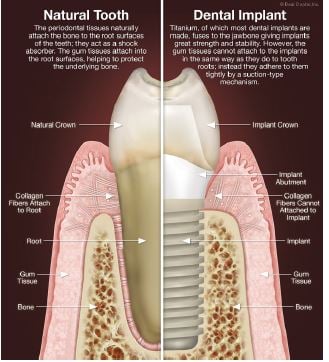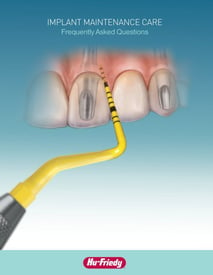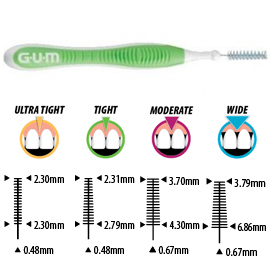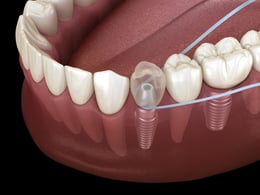
An Update on Implant Maintenance

Are Implant and Natural teeth supporting structures the same?
They are not, the differences in the supporting structure of the implant make them more susceptible to inflammation and bone loss when plaque accumulates as compared to the teeth. Therefore, a comprehensive maintenance protocol should be followed to ensure the longevity of the implant. (Fig1)
Good oral hygiene must take place before, during, and after placement of dental implants to ensure the health of the implant. Patients are concerned about what kind of maintenance their implants will require.
Do they brush and floss their implants like regular teeth?
Does food get underneath the fixed implant bridge or prosthesis?
Patients look to their hygienists to address these concerns and help them with an individualized home-care routine. The gum tissue surrounding the implant should appear pink, firm, with no signs of infection. The peri-implant soft tissues (peri-mucosal seal) that separates the connective tissues surrounding the implant from the outside (Gum) environment should be keratinized tissue (this is the clinical term for healthy, thick and fiberrich gum tissue). The absence of keratinized tissue has been documented to be more susceptible to pathogenic bacteria thus leaving the implant vulnerable to peri-implant disease.The success of the implant depends directly on the health of this seal, and the hygienist's goal is to educate the patient on how to maintain keratinized tissue and maintain a healthy peri mucosal seal.
Once the implant is exposed to the environment, loaded (occlusal bite forces) and restored with a permanent crown or bridge, a salivary pellicle is formed followed by bacteria with the formation of biofilm.The elimination of 85% of plaque/biofilm on a daily basis is critical to the overall health of the implant.
To help the patient protect their implant(s), their investment, patients need to be aware of the following key points:
- Patients should visit the dental hygienist every 3 months to ensure proper monitoring and plaque control - maintenance of healthy gum tissues around their implants. At Maria Cardenas DMD, our dental hygienists are trained to probe, scale and polish around dental implants with the proper instruments. Choosing the right instruments and proper technique is critical to avoid scratching the implant surface and junction between crown and implant platform. (Fig2)

- Choosing safe home-care products. First, toothpaste or gel needs to be lowabrasive to not scratch the surface of any exposed surfaces of the implant (exposed threads, for example). Avoid dentifrice with stannous fluoride, sodium fluoride (APF >3.0), baking soda, stain removers, and smoker's toothpaste.
What toothbrushes and interdental products are best to use with implants?
Several studies have been conducted regarding what type of toothbrush is most effective for implants. The results show no significant difference between sonic, electric, or manual toothbrushes. The main focus needs to be on adaptation to the prosthesis and the patient's dexterity. Instruct the patient to brush the implant(s) twice daily to remove bacterial plaque with a low-abrasive dentifrice. A soft toothbrush should be used; options include a manual brush, electric, or sonic brush (examples include Oral-B Triumph, Sonicare, and Waterpik Sensonic Plus), Sulcabrush, or end-tuft brush.
Nylon coated interdental brushes/ proxabrushes are also an excellent alternative to clean especially tight and hard-to-reach areas around implants and prostheses. Nylon only interdental brushes (no metal wire) are necessary to prevent scratching the implant or prosthesis. The interproximal brushes such as GUM GO BETWEENS work extremely well and can be dipped in non-alcohol antimicrobial rinse or gel. It is extremely important to brush under, around, and in the peri-implant crevice circumferentially (Fig 3)

Floss
There are many types of floss on the market, and generally it is highly recommended to use unwaxed tape or implant-specific floss in order to protect the tissue surrounding the implant. Alternatively for a bar-retained prostheses, full fixed retained prostheses, or wider interproximal spaces, a floss threader or a specialized floss that has a built-in threader is necessary.
To floss the implant, use dental tape and insert the floss in contacts on both sides of the implant. Wrap in a circle and crisscross in front, switch hands, and move in a shoe-shine motion into the peri-implant crevice, which is highly susceptible to inflammation/peri-implant disease due to biofilm1 (See Fig3. EX: Oral-B Glide
Tape Floss)

In addition, antimicrobial mouth rinses may be recommended, especially if inflammation is present or if the patient has dexterity problems, and difficult-toreach areas. If the patient is prone to inflammation, the use of an antimicrobial rinse, in conjunction with a rubber tip stimulator, may be recommended to inactivate bacteria substantive.
Oral irrigators/Water Flossers
It is highly recommended for patients to use oral irrigators for the reduction of plaque/biofilm, inflammation, and hard-to-reach emergence profiles around implants13,14 (see Figure 6a). Instruct the patient to use a nonmetal tip one to two times daily, and, if inflammation is present, add a diluted non-alcohol antimicrobial rinse (chlorine dioxide or chlorhexidine gluconate).
Studies using oral irrigators with implants for oral hygiene reveal that Waterpik Water Flosser is the only oral irrigator to date to be proven safe and effective with dental implants. Research also shows that the use of oral irrigation and floss revealed that the Waterpik Water Flosser with the standard tip with three bristle filaments (Plaque Seeker Tip) used at medium pressure around implants was 81% more effective in bleeding reduction compared to 33% using floss. These pecialized tips are very effective for implants and to deliver anti-microbial rinse around difficult-to-reach prostheses (All-on-4, full-fixed prosthesis, for example) in
a prevention of peri-implant disease.
Stimulators
Stimulators are coming back into vogue with implants and regenerative
procedures. Remember healthy keratinized tissue is the key to a healthy peri mucosal seal surrounding the implant. Stimulators are the ticket to achieve this, particularly in full-fixed, supra-structure implants, as well as implants that retain over-dentures (bar-retained implants). Examples of stimulators are rubber tip stimulators produced by multiple manufacturers and Soft Picks by Sunstar America.
Instruct the patient to place the tip of the rubber-tip stimulator so it lays flat against the gum tissue, not poking in the tissue, with pressure roll to massage and stimulate the tissue. The tissue will blanch or change to a lighter color when the correct pressure is applied.
SUMMARY OF GUIDELINES
Implant Home-Care Guidelines
- Brush twice daily with low-abrasive dentifrice.
- Floss with dental tape (mesial/distal and facial/lingual) in shoe shine motion or use a water flosser one to times daily.
- If recommended, use interdental brush, rubber tip, soft picks, and/or water irrigation unit one to two times daily.
- If inflammation present use non- alcohol anti-microbial rinse and/or add to water irrigation unit in 1:10 dilution.
Removable Prosthesis Guidelines - Remove the prosthesis (overdenture) daily to soak in specific cleaner for recommended time only.
- Do a visual check of O-rings, locator caps, and clips. Alert dental
professional if worn or missing, to be replaced. - Remove the prosthesis from the cleaner and brush the underside with denture brush, being careful not to damage the attachments.
- Rinse off the prosthesis thoroughly with water and/or non-alcohol
antimicrobial rinse. - Rinse mouth with antimicrobial for 30 to 60 seconds and reinsert the overdenture into place.
If you are interested in Dental Implants our you are in need of proper maintenance, Call our office to schedule an appointment
We look forward to helping you with all you dental implant needs.


.png?width=536&name=email_signature_-DR.-Maria-Cadenas--DMD%20(1).png)
Topics:
%20(1).png?width=1200&height=1200&name=mc%20logo%20(1)%20(1).png)


.png?width=1080&height=1080&name=Maria%20blog%20(9).png)